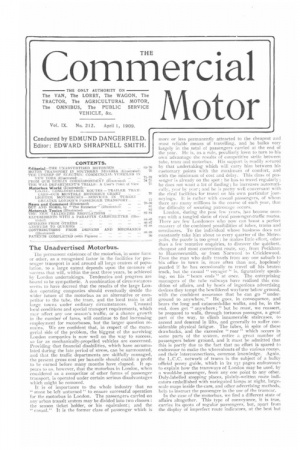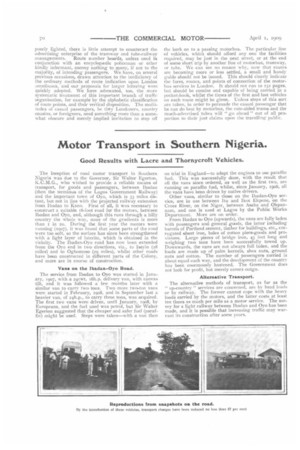The permanent existence of the motorbus, in some form or
Page 1

Page 2

If you've noticed an error in this article please click here to report it so we can fix it.
other, as a recognised factor in the facilities for passenger transport in and around all large centres of population, to a large extent depends upon the measure of succese that will, within the next three years, be achieved by London undertakings. Tendencies and progress are bound to be sympathetic. A combination of circumstances seems to have decreed that the results of the large London operating companies should eventually decide the wider future of the motorbus as an alternative or competitor to the tube, the tram, and the local train in all
large towns under ordinary circumstances. Unusual local conditions and special transport requirements, which may affect any one season's traffic, or a chance growth in the number of fares, will continue to find increasing employment for motorbuses, but the larger question remains. We are confident that, in respect of the managerial side of the problem, the biggest of the surviving London companies is now well on the way to success, so far as mechanically-propelled vehicles are concerned. Providing that financial disabilities, which have accumulated during the late period of stress, can he surmounted, and that the traffic departments are skilfully managed, the present gross cost per bus-mile should enable a profit to be earned before many months have elapsed. It appears to us, however, that the motorbus in London, when considered as a competitor of other forms of passenger transport, is operated under certain serious disadvantages which might be removed.
It is of importance to the whole industry that no " stone be left unturned " to ensure successful operation for the motorbus in London, The passengers carried on any urban transit system may be divided into two classes : the season ticket holder, or his equivalent; and the " casual." It is the former class of passenger which is more or less permanently attracted to the cheapest and mose reliable means of travelling, and he bulks very largely in the total of passengers carried at the end of the year. He is, as a rule, peculiarly keen to turn to his own advantage the results of competitive strife between tube, tram and motorbus. His support is readily secured by that undertaking which will carry him between his customary points with the maximum of comfort, and with the minimum of cost and delay. This class of passenger is already on the spot : he has to travel regularly ; he does not want a lot of finding ; he increases automatically, year by year; and he is pretty well conversant with the rival facilities for travel on his own particular journeyings. It is rather with caeual passengers, of whom there are many millions in the course of each year, that the difficulty of securing patronage occurs.
London, during the past few years, has become overrun with a tangled skein of rival passenger-traffic routes. There are few Londoners who now can boast a perfect mastery of the combined possibilities of tubes, trains and omnibuses. To the individual whose business does not constantly take him about to every quarter of the Metropolis, the puzzle is too great : he makes little effort, other than a few tentative enquiries, to discover the quickest, cheapest and most convenient route, say, from Peckham to Hammersmith, or from Norwood to Cricklewood. Even the man who daily travels from any one suburb to his office in town is, more often than not, hopelessly puzzled if he has occasionally to travel off his beaten track, but the casual " voyager " is, figuratively speaking, on his "beam ends " at once. The enterprising managers of the tube railways have realised this condition of affairs, and by hosts of ingenious advertising devices they tempt the bewildered wayfarer below ground, with the confident assurance that he can go "underground to anywhere." He goes, in consequence, and bears the long and catacomb-like walks, and he, in the end, does get " anywhere; " but he must, we reassert, be prepared to walk, through tortuous passages, a great part of the way, to climb innumerable staircases, to ascend and descend in lifts, and generally to suffer considerable physical fatigue. The tubes, in spite of these drawbacks, and the excessive " roar " which occurs in some parts of the system, entice a great number of passengers below ground, and it must be admitted that this is partly due to the fact that no effort is spared to endeavour to make the whereabouts of the various routes, and their interconnections, common knowledge. Again, the I..C.C. network of trams is the subject of a bulky official penny guide, which in its 132 pages endeavours to explain how the tramways of London may be used, by a would-be passenger, from any one point to any other, Duly-labelled stopping places, plainly-written route indicators embellished with variegated lamps at night, largescale maps inside the cars, and other advertising methods, help to instruct the passenger in the LI se of the tramcar.
In the case of the motorbus, we find a different state of affairs altogether. This type of conveyance, it is true, carries its quota of regular passengers, but, apart from the display of imperfect route indicators, at the best but
poorly lighted, there is little attempt to counteract the advertising enterprise of the tramway and tube-railway managements. Route number boards, unless used in conjunction with an encyclopedic policeman or other kindly informant, convey nothing to many, if not to the majority, of intending passengers. We have, on several previous occasions, drawn attention to the inefficiency of the ordinary methods of route indication upon London omnibuses, and our proposals for larger lettering were quickly adopted. We have advocated, too, the more systematic treatment of this important branch of traffic organisation, for example by the alphabetic classification of route points, and their vertical disposition. The multitudes of casual passengers, be they Londoners, country cousins, or foreigners, need something more than a somewhat obscure and merely implied invitation to step off
the kerb on to a passing inotorbus. The particular line of vehicles, which should afford any one the facilities required, may be just in the next street, or at the end of some short trip by another line of motorbus, tramway, or tube. We can see no reason why, now that routes are becoming more or less settled, a small and handy guide should not be issued. This should clearly indicate the fares, routes, and points of connection of the motorbus services in London. It should not run to 132 pages, but should be concise and capable of being carried in a pocket-book, whilst the times of the first and last vehicles on each route might be given. Unless steps of this sort are taken, in order to persuade the casual passenger that he can do best by motorbus, the rate-aided trams and the much-advertised tubes will "go ahead" out of all proportion to their just claims upon the travelling public.






















